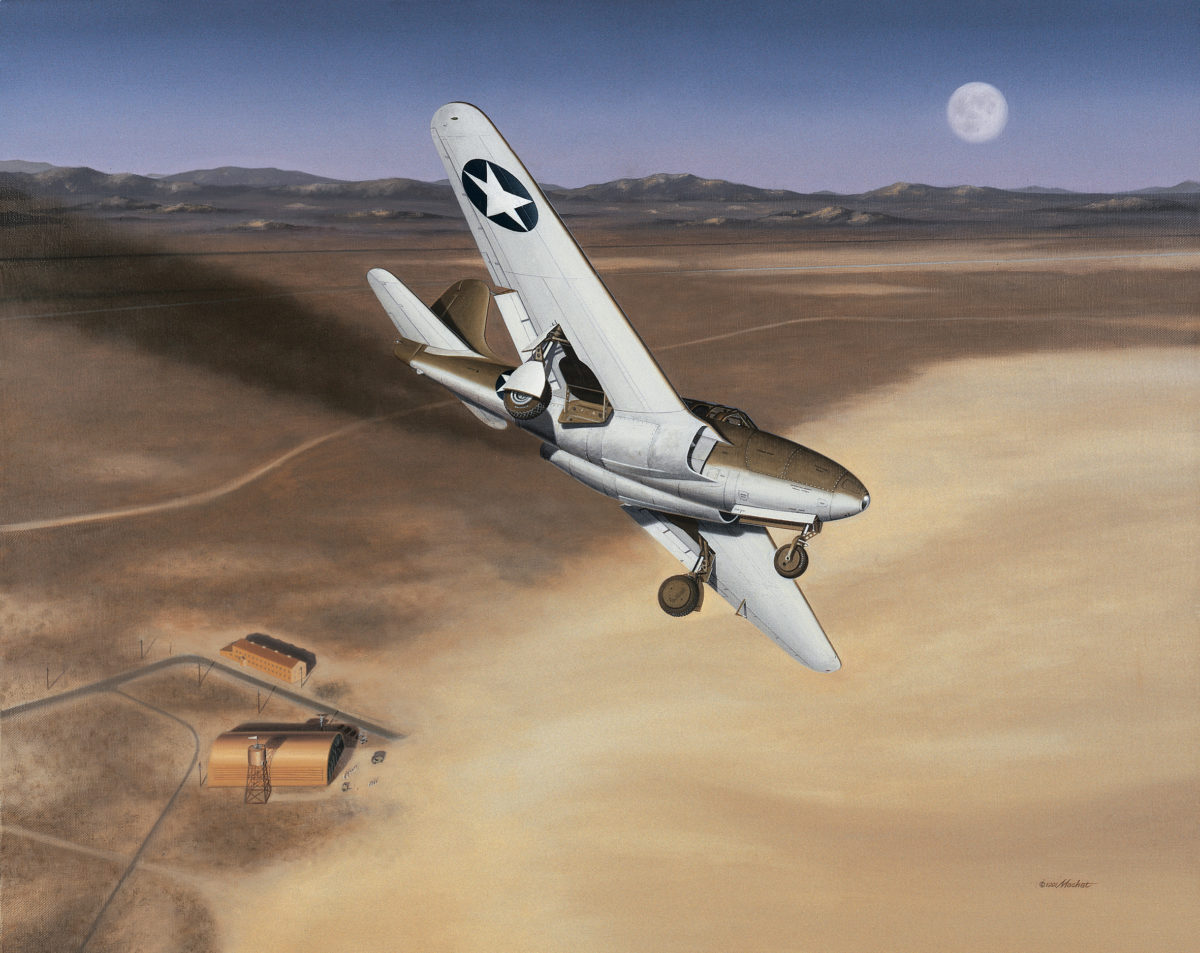Although the Bell P-59 Airacomet was the United States’ first jet airplane, it had been preceded by five others—all made in Europe.
There was the German Heinkel He-178, which made its first test flight on August 24, 1939. That was followed by the Italian Caproni-Campini N.1 a year later. Then there was the Heinkel He-280, which was airborne in April 1941. The British Gloster E.28/39 took off in May 1941, and the German Messerschmitt Me-262 in July 1942. The Airacomet did not fly until October 1942.
The Airacomet’s history began with designs for two fighter aircraft proposed in 1935 by the Bell Aircraft Corporation in Buffalo, N.Y. Bell’s engineers began exploring the possibilities of pusher-propeller aircraft as interceptors and proposed the single-engine XP-52 and XP-59, both equipped with tricycle gear, twin tail booms and counter-rotating propellers. The XP-52 was expected to have a 1,250-hp Continental XIV-1430-5 liquid-cooled pusher engine, reach 435 mph and carry two 20mm and six .50-caliber machine guns. That contract never got beyond the mock-up stage and was canceled. The XP-59, also a twin-boom design, was to have a 2,000-hp radial pusher engine and was estimated to reach 450 mph.
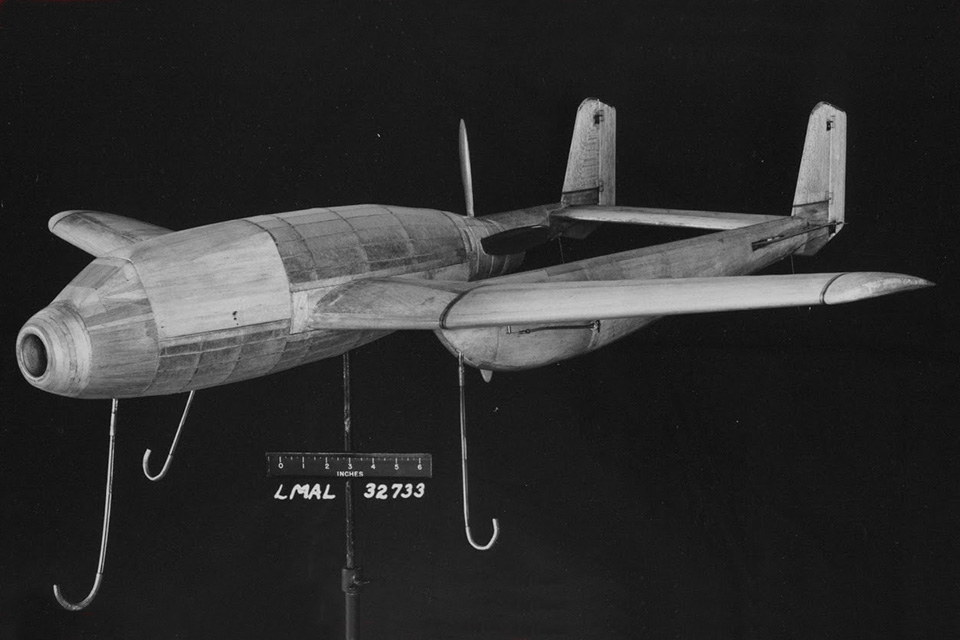
As the XP-59 drawings reached a point at which blueprints should begin to turn into metal, history intervened in April 1941. Major General Henry H. “Hap” Arnold, chief of the Army Air Corps, traveled to England on a fact-finding mission to assess British war production capabilities. General Arnold later recalled that the most important information he received during the trip was at the Royal Air Force’s Cranwell Field, where he saw the first British jet-propelled aircraft. It was the Gloster E.28/39, powered by a W.2B turbine engine developed by RAF Commander Frank Whittle, who had been granted the world’s first jet engine patent.
Arnold was fascinated by the Gloster, which he referred to as “a plane such as I had never seen before.” He recalled in his autobiography Global Mission that “as far as I knew, no such device had yet advanced beyond the drawing board stage here in America. In England I saw this propellerless plane taxiing around the air field and making short flights. I knew then and there I must get the plans and specifications of that jet plane back to the United States.”
Arnold conferred with William Maxwell Aitken, 1st Baron Beaverbrook, who was in charge of all British war production, and with Colonel John T. C. Moore-Brabazon, minister of aircraft production, who agreed that he could take the plans and specifications that were ready home with him, and the rest would follow as they were completed. The only restriction was that the entire project be kept top secret. As John Golley, a Whittle biographer, pointed out: “Thus America received a virtually free passport into the field of aero gas turbines, entirely brought about by Whittle’s guts and determination to bring his project to fruition. The deal with America could not have come at a better time…when America was neutral and Britain, fighting alone, desperately needed American arms.”
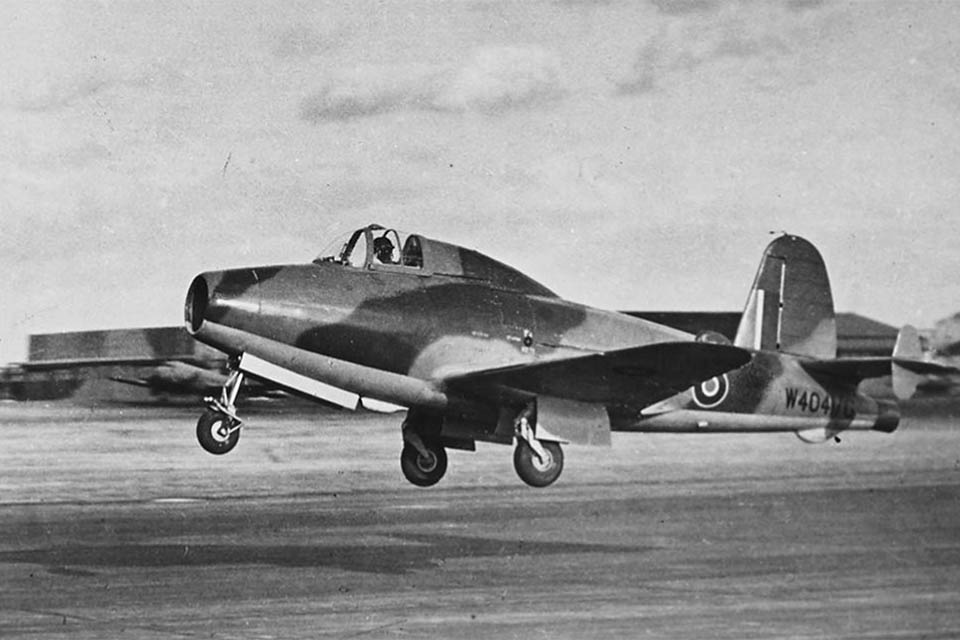
Arnold was confident that the Whittle engine showed great promise. The original Whittle W.1X engine weighed only 650 pounds, and British experiments indicated that it might propel a plane at 300 mph at 40,000 feet. “This was far better performance than that of any of the orthodox-type airplanes,” Arnold noted. “The number of moving parts in the jet-propelled plane was cut down to about one-fifth the number used in the orthodox combustion engine aircraft. The greatest disadvantage of the jet engine was its tremendous consumption of fuel. It used about twice the amount required by an ordinary engine. On the other hand, it could burn any kind of fuel—alcohol, kerosene or diesel oil, or, the RAF swore, mild and bitter beer!”
Arnold hurried back to Washington, anxious to get plans for America’s first jet underway. He sent a small group to Britain to evaluate the technical aspects of the Whittle engine and gain assurance that release of all information on jet propulsion was forthcoming from the British government. When satisfied that he could proceed, he invited Lawrence D. Bell of the Bell Aircraft Corporation in Buffalo and D.R. Shoultz, turbine expert from the General Electric Company at West Lynn, Mass., to meet with him in Washington on September 5, 1941.
Arnold was well acquainted with Bell’s personal drive and enthusiasm for research and development. His earlier aircraft designs, such as the XFM-1 Airacuda, the only twin-engine pusher fighter built in the United States, and the P-39 Airacobra, the first production warplane with tricycle landing gear, had not been successful but displayed an innovative flair with an eye on the future.
Arnold also knew of General Electric’s long history of work with steam, water and turbine air compressors, plus turbosuperchargers for aircraft engines and experience with heat-resistant alloys used in high-speed turbine blades. The company’s experience with turbine engines dated back to 1903, when Sanford Moss developed a crude gas-turbine engine with an exhaust-gas-operated air compressor. During World War I, Moss developed a turbosupercharger using exhaust gas to drive a compressor supplying air to an aircraft engine intake. In 1919 his turbosupercharger was installed on a Packard-LePere biplane that set high-altitude records. He also was the first to successfully burn fuel continuously in a chamber under pressure.
Arnold was confident that the Bell-GE combination was an ideal match. The relative proximity between the two manufacturing facilities would not only facilitate communication between the engineers involved but would also help to maintain the project’s security.
It was agreed that Bell would design and build three airframes, and General Electric would supply 15 versions of the British engine design. Every precaution was to be taken against leakage of the project’s details, and it was initially assigned an unusual “Special Secret” security classification.
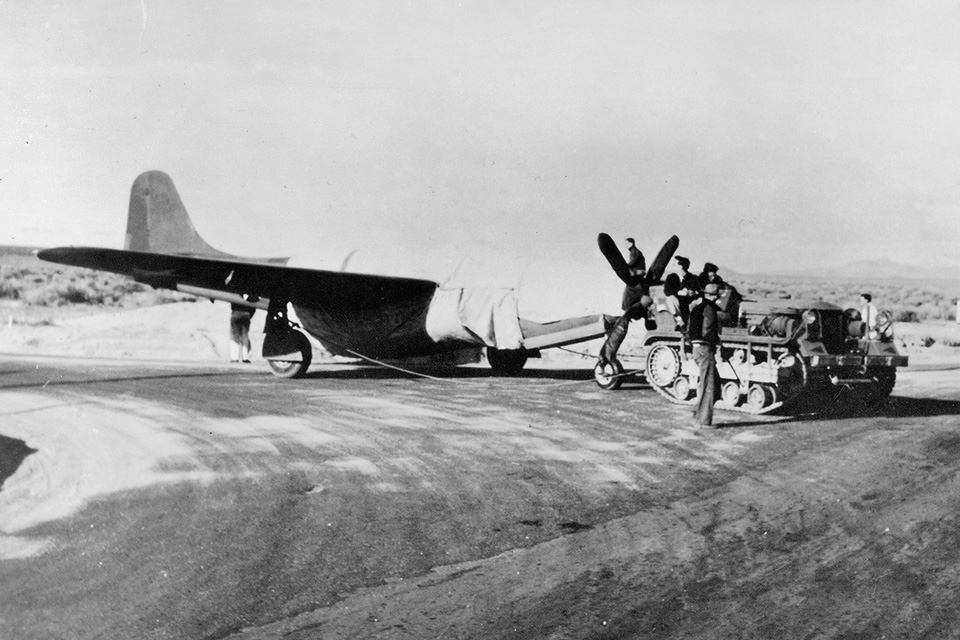
A $1.6 million contract with Bell, signed on September 30, 1941, called for the first aircraft to be delivered eight months later. The plane was designated the XP-59A—so it would appear to be a continuation of Bell’s prop-driven XP-59 design, which would be cancelled in December 1941. Bell assembled a team to design and build the prototypes and impressed upon it the need for absolute secrecy. The engineers were moved to a former Pierce-Arrow automobile factory in downtown Buffalo. Later on, production was moved to the second floor of a three-story building, where a machine shop took the place of a Ford car agency. The building’s windows were welded shut and the glass painted over. Guards were placed around the building on 24-hour watch.
The Bell engineers were given free rein in the aircraft’s design with the proviso that it had to accommodate the twin jet engines that GE’s engineers would eventually provide. Meanwhile, Whittle’s W.1X engine was delivered to the GE plant in West Lynn, and a special engine test cell was constructed. The first test run was made on November 1, 1941, but GE’s engineers found some omissions and discrepancies in the drawings that accompanied the engine and made changes that resulted in the first GE model, designated the I-A. Its first test run was made in March 1942. Whittle arrived from England in June 1942 to help solve excessive gas temperature problems.
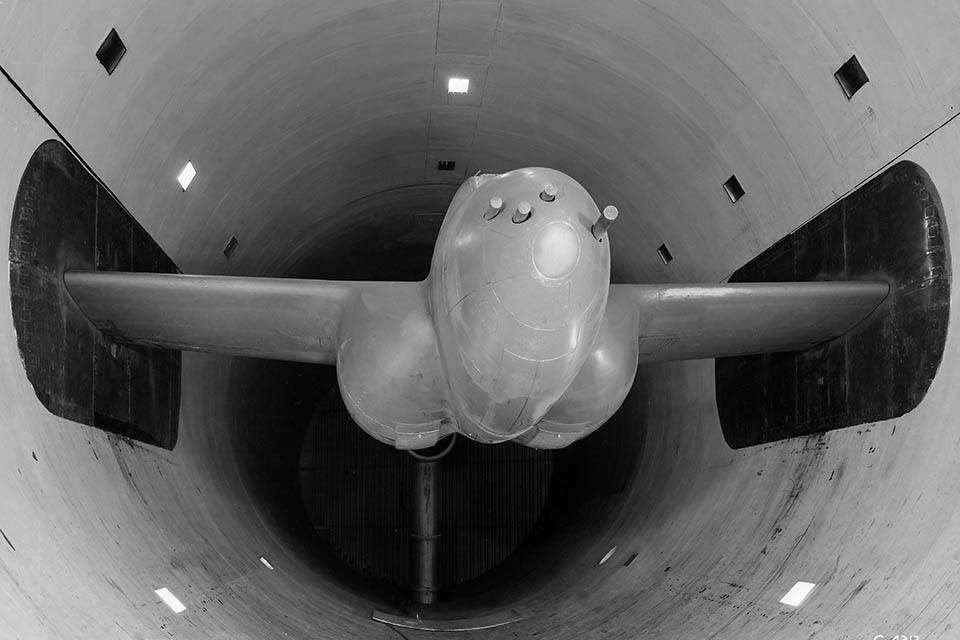
It had been decided from the beginning that the XP-59A would eventually be a production fighter, not just an experimental plane with no combat mission. The original armament specification called for two 37mm cannons in the nose compartment. A 1/16-scale model was tested secretly in a wind tunnel at Wright Field, Ohio, as the plane’s shape was defined.
Work on the first plane began on January 9, 1942. Fabrication of its component parts had to be farmed out to Bell’s main factory, where the drawings were disguised with false labels. A month later, Bell was asked to submit an estimate to produce 13 YP-59As for service tests, plus a plane for static tests, wind tunnel models and spare parts. Those aircraft were to be essentially the same as the three X models, except that they would have a sliding canopy instead of a hinged canopy that was raised over the pilot’s head.
While the first planes were being manufactured, a search was underway for a secure location for test flights, which could not be carried out near Buffalo. The location chosen was the Army Air Forces bombing and gunnery range on Rogers Dry Lake in the Mojave Desert area of California. The dry lake bed covered about 65 square miles with no obstructions, making it ideal for testing aircraft that might need much takeoff and landing space.
The first jet engine arrived in Buffalo on August 4, 1942, and the first XP-59A was ready for shipment on September 10. To provide access for the plane, workmen had to knock a large hole in the side of the brick building, after which three large crates were lowered onto two railroad flat cars. To assure that the high precision bearings in the engines would not be damaged by the pounding of the rails, a small door was cut into the side of the fuselage crate and an air compressor was hooked up with a flexible pipe to pump air to the engines and keep the turbine blades rotating. An officer and five enlisted men plus three GE mechanics were assigned to the equipment to be sure the turbines would be turning continually for the entire trip. One veteran trainman, puzzled about the compressor blasting away day and night, said to one of the GE men, “Hey, send me a telegram collect when the war’s over and tell me what’s in those crates.”
Larry Bell, meanwhile, chose chief test pilot Robert M. Stanley to establish and run the initial flight test program. Stanley’s experience with aircraft dated back to 1931, when he worked for the Douglas Aircraft Company, then graduated from the California Institute of Technology with a degree in aeronautical engineering and joined the Navy for a four-year tour as a pilot. He started working for Bell in 1940.
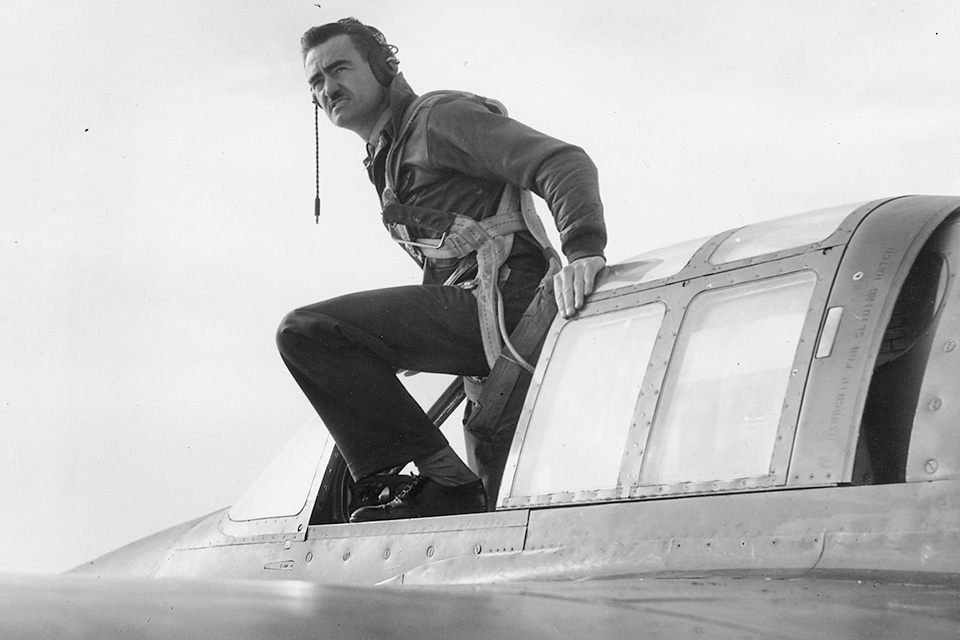
Stanley familiarized himself with the aircraft and the operation of the jet engine before departing for California. He was not pleased when he arrived to find that little had been done to accommodate the men who would be conducting the tests and meet the October 2, 1942, date that had been designated for the first official flight. He quickly made arrangements with a contractor to construct a new base on the north side of Rogers Lake, away from prying eyes. There was some resistance from the base commander, who didn’t concur with the urgency of his demands, but Stanley was determined to have barracks and a hangar erected by the time the first plane arrived. When the date neared, he ordered the civilian workers out, and the work on the facility was completed by a dozen Bell employees from Buffalo.
The fuselage and wings were unloaded at the Muroc Army Air Field and trucked under wraps to the Bell hangar on September 20. The fuselage and engine mating was completed on the 26th, and engine run-ups were conducted. Larry Bell arrived on the 30th to witness Bob Stanley’s initial taxi tests. That day, Stanley made what he called “high taxis” when he roared down the lake bed and lifted off a foot or two before cutting the engines and taxiing back.
On October 1, Stanley cautiously ventured higher. The log kept by Ed Rhodes, Bell’s project engineer, read: “Four flights just off the ground were made, wheels down. Nose wheel shimmied some. Adjusted. Then OK. Takeoff distance about 2,000 feet, 80–90 mph, varying heights, 25 to 100 feet. Critical temperatures OK. Fuel cross flow OK.” Stanley’s test log for the first flight stated: “Duration of flight: thirty minutes. Throttle was applied promptly and acceleration during takeoff appeared quite satisfactory….The first flight reached an altitude of approximately twenty-five feet.”
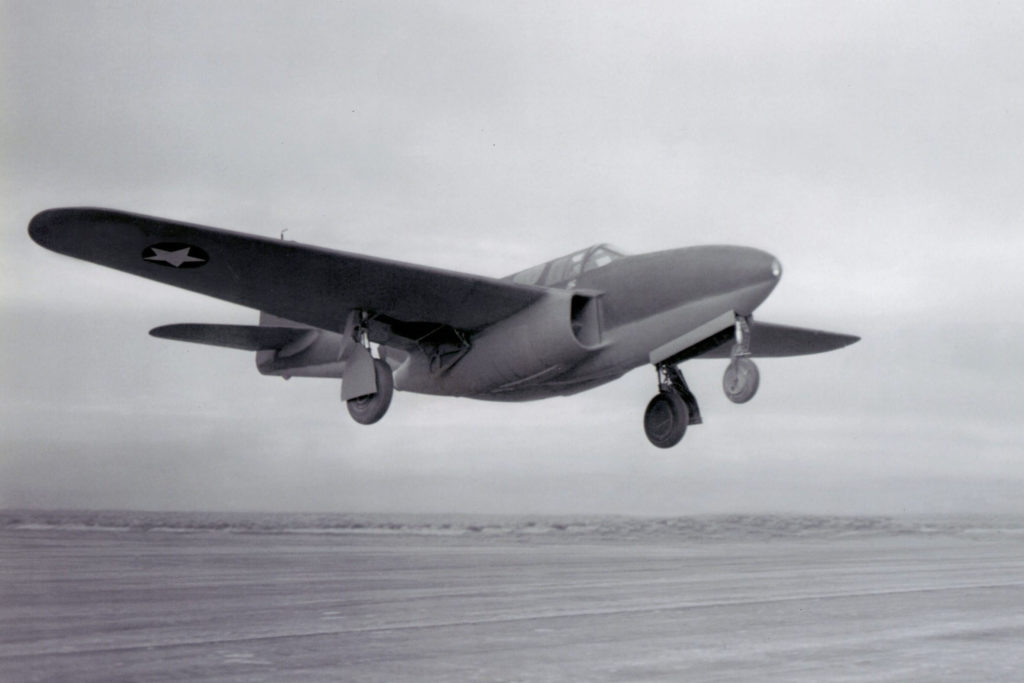
A total of four official flights were made as scheduled on October 2, before a small group of government, GE and Bell civilians and Army Air Forces officers. Stanley climbed to 6,000 feet on the first flight and 10,000 feet on the second. The third flight was made by Army Air Forces Colonel (later Lt. Gen.) Laurence C. Craigie, chief of the Aircraft Projects Branch at Wright Field, Ohio, who thus became the first American military pilot to fly a jet.
On Stanley’s final flight that day, he planned to climb above 10,000 feet, but the gear vibrated on takeoff and retracted only halfway. Disappointed but not wanting to push his luck, he lowered the gear and landed.
“But you got to 10,000 feet!” Bell said, shaking his hand, as Stanley dismounted. “That makes it a respectable day, all around. We’ve got an airplane, and you proved it!”
Plane No. 1 did not fly again for a month. The landing gear was repaired, and an observer’s cockpit, with a standard seat and an instrument panel, was installed in the space in front of the pilot’s cockpit. Thus, the XP-59A became the world’s first two-seat jet aircraft. Ed Rhodes, whose assignment was to make notes during test flights, had the honor of being the first jet passenger.
Test flights continued, and other pilots checked out as the second plane arrived from Buffalo. It had the specified armament installed, while the first XP-59A did not. Several pilots complained that they had to use excessive force on the rudder. Stanley took Plane No. 2 up, checked it out and returned in a huff. He got out of the cockpit, called for a hacksaw, got up on a ladder, cut a few inches off the top of the rudder and smoothed the edges. He threw the pieces away, jumped into the cockpit, taxied out and took off. When he returned, all he said was, “Works much better that way.”
In retrospect, after more test flights, Stanley said, “I had less trouble and fewer mechanical interruptions than with any other prototype I’d ever flown.” Jack Woolams took over as test pilot at the desert site and made a number of flights in one of the XPs. On July 14, 1943, he was able to coax it to an unofficial record high altitude of 45,765 feet.
The test program had to slow down at that point because of the unsatisfactory performance of the engines. One major problem was overheating of the engine bearings. Those engines, copied from a newer British W.2B engine, could never reach the expected level of thrust, and the British demand for strict secrecy prevented satisfactory tests being conducted on the XP-59A’s intake duct design. The GE I-A engine was improved in successive models. Bell was forbidden to use any facilities except those of the military, so those of the National Advisory Committee for Aeronautics (NACA) and industry vendors were not made available. The best wind tunnel at Wright Field was incapable of properly measuring high engine thrust.
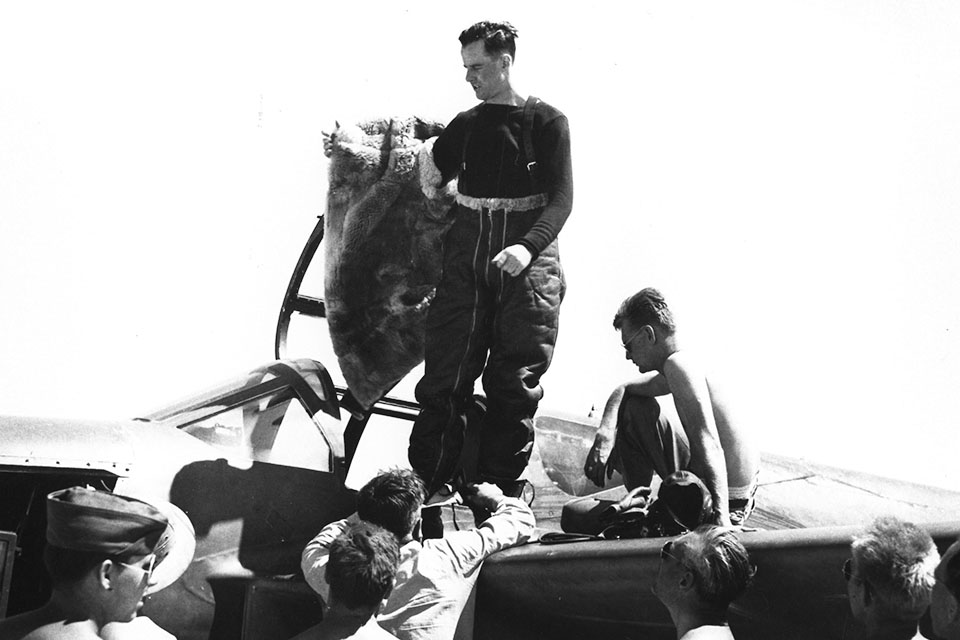
Production of the YP-59As continued at the Bell factory, with the first one arriving at the test site in June 1943. There were further delays because of the canopy change and difficulty with the ailerons. The first flight of a YP-59A was in August 1943. In subsequent flights, one reached an altitude of 35,160 feet and a true air speed of 389 mph. In December, Woolams raised his unofficial U.S. altitude record for single-engine aircraft to 47,600 feet flying a YP-59A.
Modifications were made in several YPs as they became available over the next few months. The last of them had a second cockpit with flight controls added, to be used as a drone “mother ship” and to take ground personnel on short hops to reward them for their work. It also had the distinction of being the first U.S. jet aircraft to carry mail and make firing tests of .50-caliber nose guns.
The U.S. Navy became interested in how the P-59 might be adapted to fleet operations. The first Navy pilot to check out in a jet was Captain (later Admiral) Frederick M. Trapnell, chief of flight test for the Bureau of Aeronautics, who was airborne on April 21, 1943.
Trapnell later recalled that “the aircraft was obviously a very gentle type of high-altitude fighter with low wing loading. It was a great surprise to find that the thing was very quiet and smooth from the pilot’s point of view. During takeoff the rattling of the landing gear was audible and the general impression was that of a glider. The XP-59 was comparatively low powered and this was apparent from the shallow climb-out. Its performance was, at first, distinctly unimpressive—long takeoff and slow rate of climb.”
The Navy received its first jets when two YP-59As arrived at the Naval Air Station at Patuxent River, Md., for testing in November 1943. The Navy acquired three more P-59Bs, which it designated XF2L-1s, in late 1945, and the last one remained in service until November 30, 1949.
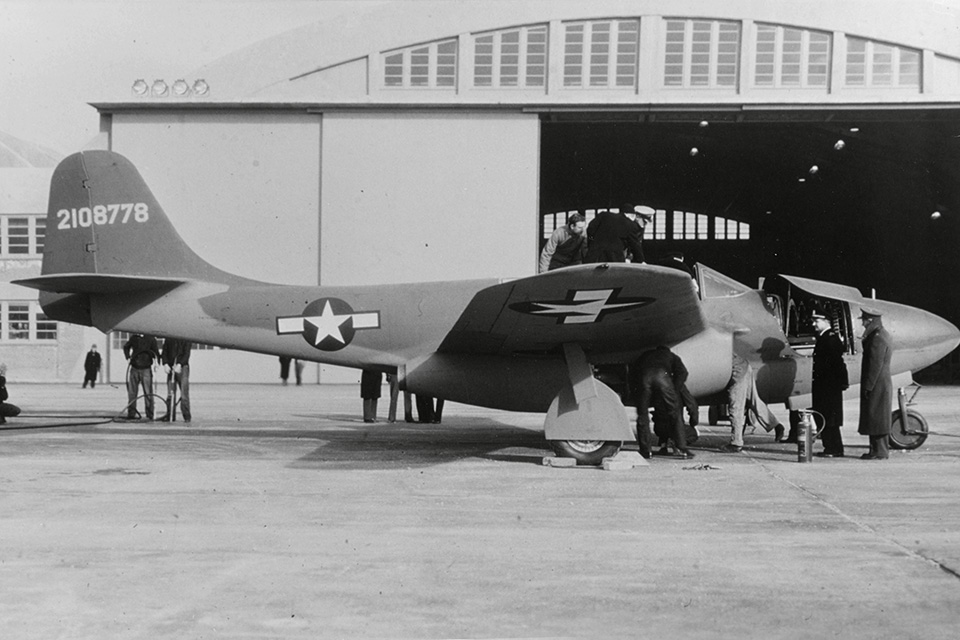
As more personnel became acquainted with jet operations, it became obvious there had to be new safety rules during ground operations. The reason was found in a Bell flight test log dated February 10, 1944: “On this date, Bell inspector, E.F. Fisher, weighing 200 pounds, walked into the jet approximately four feet behind the nozzle while the aircraft was operating at rated power. It lifted him approximately three feet in the air, tumbled him end over end approximately three times, and he made a face-down landing on the concrete surface.” Fortunately, Fisher suffered no substantial injuries.
Over the time of the service testing, major modifications were made on the YP-59As to increase performance. These included squaring off the rounded wingtips, vertical stabilizer and ventral fin; strengthening the aft fuselage; replacing the fabric-covered flaps and ailerons with metal; and providing the pilot with main landing gear up-locks. While those changes were necessary and improved the plane’s capabilities, a major question still to be answered concerned its potential as a fighter. Unfortunately for the P-59A, in air-to-air combat tests in February 1944, it proved unstable as a gun platform. The Airacomet was outclassed in dogfights against Republic P-47D and Lockheed P-38J fighters, and dive tests led to speed restrictions for the new jet.
During the lifespan of the P-59 program, several different engines were installed, beginning with the General Electric I-A, rated at 1,250 pounds of thrust. Later models—the I-14 and I-16 (later designated the J-31)—boosted the power to 1,400 pounds of thrust, to give the Airacomet speeds only slightly faster than the piston-engine fighters of that day. The best speed attained by an XP-59A was 389 mph, and a YP-59A reached a top speed of 414 mph. They were outmatched by the German Messerschmitt Me-262 and the Heinkel He-280, which were designed for speeds exceeding 500 mph and thus were markedly superior to all Allied fighters.
The results of the YP-59A tests were studied by an evaluation board of the Materiel Command Service Test Agency in mid-1944. The board’s report stated, “it is not believed that the P-59 airplane is operationally or tactically suited for combat nor is it believed that any modifications to this aircraft, short of a completely new design, would improve its combat suitability.”
The board concluded, “although the aircraft is not suitable for combat, there is a requirement for a limited number of subject airplanes to be utilized for jet training and for general Air Force familiarization….The P-59 will make an excellent training ship in that its low wing loading makes the airplane very safe for transition flying and the fact that it has two engines is an added safety factor.” Production of the P-59 would proceed.
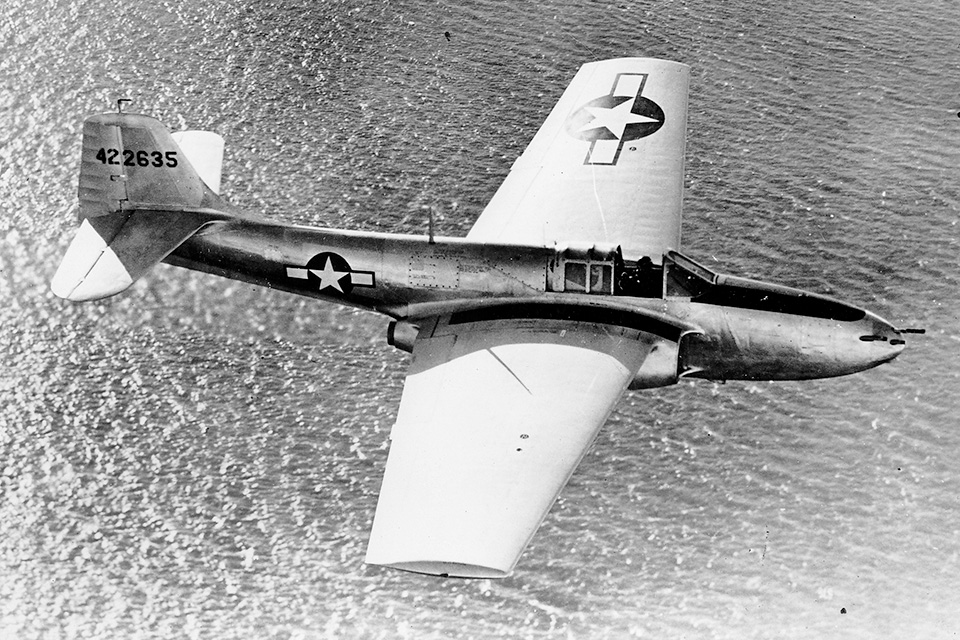
Bell proposed in 1943 to build 300 P-59s, but since such an order would hamper the production of P-63 fighters and GE could not turn out enough of its I-16 engines, the order was reduced to 100, then to 50 (20 P-59As and 30 P-59Bs), at a cost of $123,500 each. A total of 66 P-59s were produced.
The 412th Fighter Group, formed in November 1943, was selected as the first unit to transition pilots to the P-59, first at Muroc Army Air Base, then at Palmdale, Bakersfield and Santa Maria in California. There are no reported figures on the number of pilots who received their first jet experience in the P-59, nor are statistics available on the accident rate, but one unusual incident was recorded at Santa Maria. An unidentified pilot eased into the traffic pattern and turned on the final approach with the wheels retracted. He did not heed the tower’s pleas to go around and skidded for about 100 feet on the plane’s belly. He quickly pushed the throttle forward and had enough speed to get airborne again. He put his gear down on the next approach and made a normal landing. The belly of the fuselage and the two engine ducts were damaged, but the plane was quickly repaired and put back in service.
In late 1944, with the dive tests completed at the desert site, Jack Woolams returned to the Bell factory at Niagara Falls, N.Y., and continued more test flights with P-59s off the production line. In four successive dives, stress effects from the pull-outs were found in the horizontal stabilizer. Repairs were made, but on the fifth dive, at about 25,000 feet, the entire tail section tore off and Woolams was trapped in the cockpit when he couldn’t slide the canopy back. He did, however, manage to break the plexiglass with his feet and bail out. He parachuted to safety, but lost his winter flying boots and had to walk barefoot nearly two miles in deep snow to get to a farmhouse.
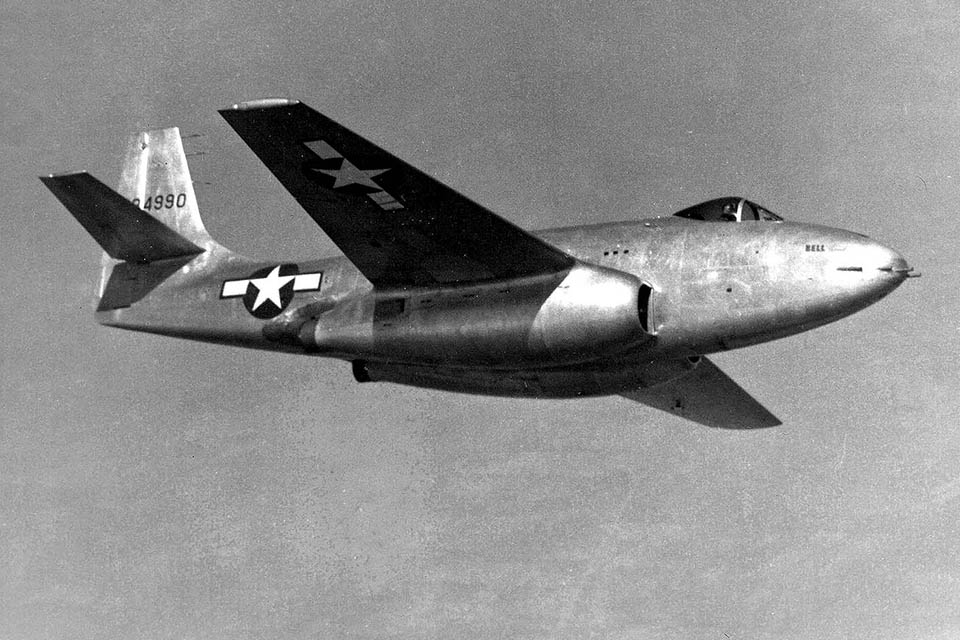
The story of the P-59 did not end when Japan surrendered on August 14, 1945. One P-59A was used in a test program in 1948-49 in an attempt to extend its range. That aircraft was towed by a Boeing B-29 on long flights as an experiment to see if a jet fighter could be made available if the bomber were intercepted. The experiments were cancelled because of the fighter pilots’ fatigue, problems recovering the P-59 and the effect on the B-29’s performance.
Another attempt to give a jet more range was the Bell XP-83, a larger version of the P-59A with a bubble canopy. It had more fuel capacity, more armament (six .50-caliber machine guns or four 20mm or 37mm cannons in the nose) and more powerful GE J-33 engines with 3,750 pounds of thrust. An order was placed for two aircraft on July 31, 1944, and the first flight took place on February 27, 1945. After brief flight tests, the project was cancelled when the planes’ performance proved disappointing.
During the months of the Airacomet’s testing, Lockheed Aircraft Corporation had been secretly working on an alternate design for a jet fighter. On January 8, 1944, only 143 days after getting the go-ahead, the Lockheed XP-80 Shooting Star made its first flight. Subsequently, nearly 2,000 P-80s were built. It proved to have remarkable versatility and was the first U.S. fighter to exceed 500 mph. Its offspring, the T-33, proved to be an excellent jet trainer, and more than 5,850 were built for the U.S. Air Force, Navy and allied nations.
Although the P-59 quickly faded into history upon the arrival of the P-80, it had made a significant contribution to American aviation history. Begun several years behind the German and British developments, it provided American pilots with valuable experience during a critical transitional period in U.S. Air Force history.
A final report on the P-59 project, dated June 28, 1945, stated, “Even though a combat airplane did not result from the development of the X and YP-59A airplanes, it is considered that the development was very worthwhile, since it proved that the principle of jet propulsion for aircraft was sound and practical.”
An award-winning author, C.V. Glines was a regular contributor to Aviation History. For further reading, try: Jet Pioneers, by Grover Heiman; and Whittle: The True Story, by John Golley.
This feature originally appeared in the March 2003 issue of Aviation History. Don’t miss an issue, subscribe today!

